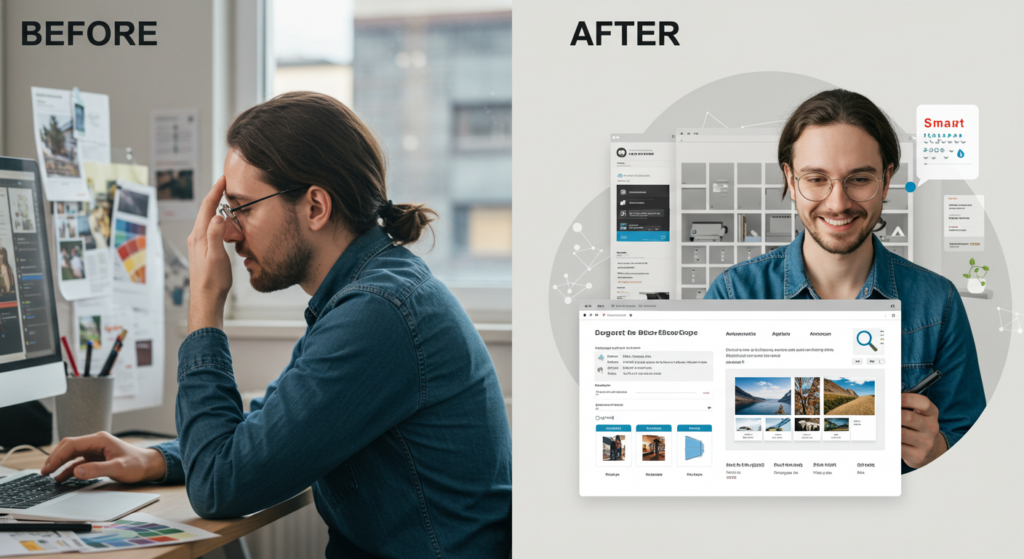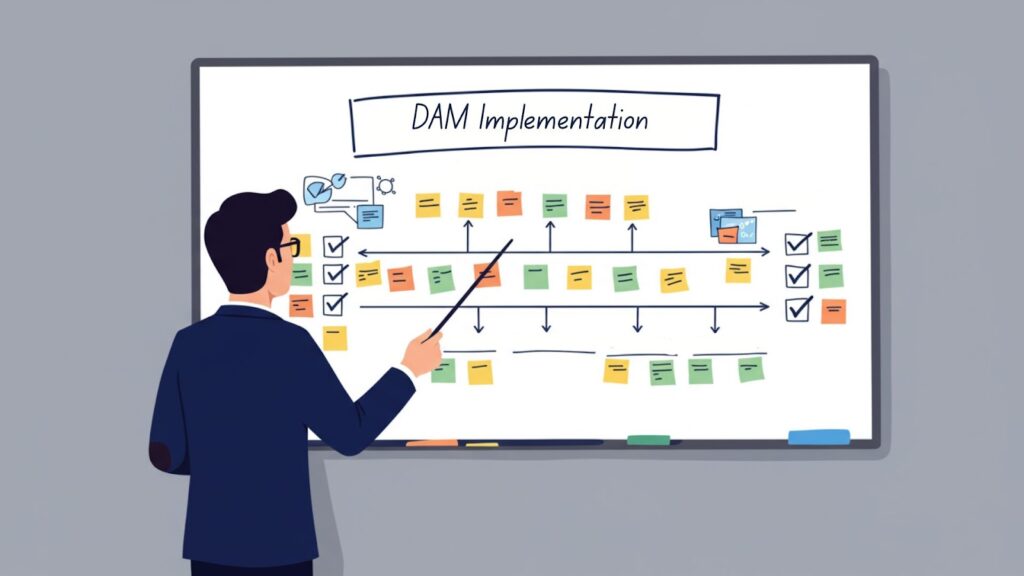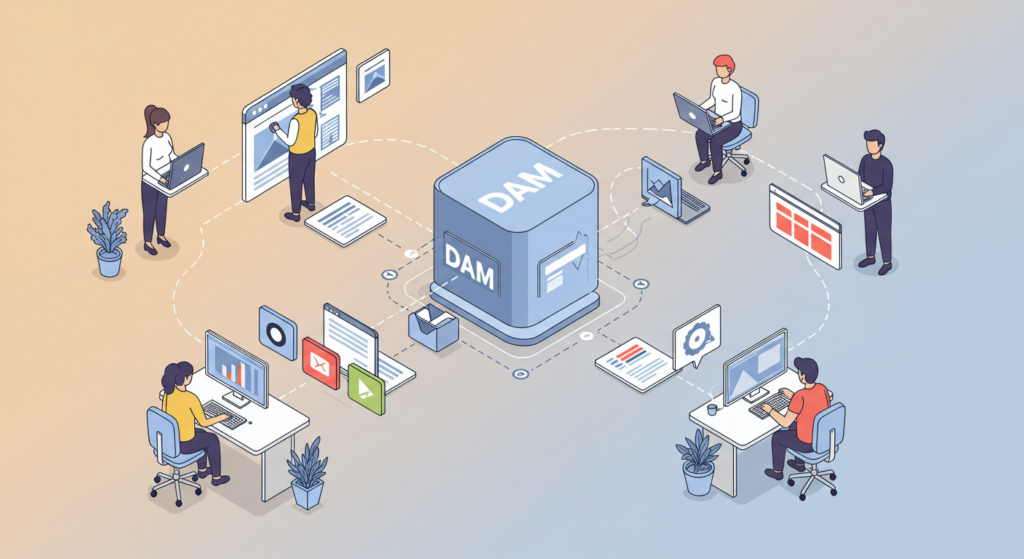The stakes have never been higher for getting digital asset management (DAM) right. The global DAM market is experiencing unprecedented growth, projected to surge from $4.59 billion in 2024 to $16.18 billion by 2032, a compelling 17% compound annual growth rate that reflects how critical these systems have become for business operations.
Successful DAM implementation isn’t just about storage and organization anymore. Today’s leading companies are leveraging AI-powered automation, real-time collaboration tools, and intelligent search capabilities to transform their content operations entirely. Remote teams need instant access to brand-approved assets, AI tools require properly tagged training data, and personalization engines demand content that can adapt across multiple channels in milliseconds.
Whether you’re migrating from a makeshift solution that’s finally hit its breaking point or implementing your first enterprise-grade DAM system, the approach you take will determine whether your investment delivers transformational results or becomes another underutilized software purchase. The companies getting digital asset management implementation right are seeing remarkable returns: 40% faster content retrieval, 53% reduction in asset duplication, and 26% faster campaign launches.
This comprehensive guide will walk you through exactly how to plan, execute, and optimize a DAM implementation that drives real business value. We’ll cover everything from AI-powered features and integration strategies to change management and measuring ROI.
Why a Digital Asset Management Implementation Plan is Needed
Inefficient digital asset management results in lost time and revenue as teams struggle to locate files or are forced to recreate content that could have been reused effectively. Even if you’re already using a DAM system, it could be outdated or lacking in features that would better suit your organizational needs.
So, when adopting a new DAM system or revamping your strategy to manage the system you already have, it’s important to think strategically about your digital asset management approach. Crafting a DAM implementation plan will save your team precious time and lead to better customer experiences across all your marketing channels.
Benefits of Implementing a DAM System
Effective digital asset management implementation provides benefits across multiple levels in your organization, including:
- Centralized and Organized Assets: If you’ve ever struggled to search through endless layers of subfolders to find the right asset or experienced the frustration of discovering that you and your collaborators were working on different versions of the same file, then you know how important it is to have a unified source of information. Properly implemented DAM systems simplify asset retrieval and track file version updates to ensure that everyone is on the same page.
- Streamlined Workflows: DAM systems boost productivity by enabling teams to work on the same assets simultaneously in real time. By integrating with other platforms in your software ecosystem, such as Adobe’s creative editing suite, implementing a DAM system can optimize the pipeline from content creation to publication.
- Consistent Brand Experience: By maintaining a single source of approved brand assets like logos, guidelines, and templates, DAM systems reinforce a consistent brand identity and make it easier for teams to adopt an omnichannel marketing approach. Implementing a DAM solution provides teams with the technical framework they need to stay on point with brand messaging and deliver engaging audience experiences.
- Better ROI: Spending less time on repetitive tasks like file conversions and metadata tagging means having more time for creative tasks and strategic thinking. Implementing a DAM system can reduce user workload through intelligent automation, allowing for faster campaign launches and better resource management. Organizations typically see faster asset creation and annual savings on agency costs from improved content reuse and efficiency.
- Enhanced Data Security: Permissioned user access and industry-leading data security certifications are things you should always look for when implementing a DAM solution. If you know exactly where your assets are and who can access them, then you can exercise greater control when protecting sensitive content and ensuring legal compliance.
- Maximized Asset Utilization: Implementing a DAM system is key to getting the most out of your assets because it improves asset visibility, making it easier to locate and repurpose existing assets to adapt them for reuse and maximize their lifetime value. Additionally, generative AI tools integrated with DAM software make it easier than ever to reshape digital content quickly.
- Deeper Insights: By implementing a DAM system that offers analysis and insight into asset performance, usage patterns, user engagement, and other metrics, you can take a more strategic approach to content creation and distribution.
AI-Powered Features Transforming DAM Implementation
The most successful digital asset management implementations are fundamentally different from those just two years ago. AI integration has moved from experimental to essential, requiring organizations to rethink their implementation strategy from the ground up rather than retrofitting AI capabilities later.

Implementation-Specific AI Considerations
Training Data Requirements: Unlike traditional DAM deployments, AI-powered systems need carefully curated training datasets during implementation. Your migration strategy must include identifying high-quality, properly representative assets that will teach the AI system your organization’s specific visual language and brand standards.
Custom Model Development: Leading organizations are implementing DAM systems with custom AI models trained on their specific terminology, product lines, and brand guidelines. This requires collaboration between your DAM vendor, IT team, and brand managers during the implementation phase.
Advanced Computer Vision Integration
Modern implementations leverage multiple AI technologies working in concert. Computer vision analyzes visual elements while natural language processing examines embedded text and file names. Meanwhile, machine learning algorithms continuously improve accuracy based on user behavior and content performance data.
Your implementation team needs expertise, such as understanding how AI accuracy improves over time and how to measure and optimize these learning systems.
Real-Time Content Intelligence During Migration
AI-powered systems can analyze your existing asset library during migration to identify content gaps, duplicate variations, and optimization opportunities that would take human teams months to discover. Some organizations are using this intelligence to inform their content strategy before the DAM implementation is even complete.
For example, AI analysis might reveal that your organization has 847 product images but lacks lifestyle shots for your top-selling category. This intelligence can immediately redirect creative resources during the implementation period.
Governance Automation Architecture
Unlike traditional DAM implementations, where governance rules are manually configured, AI-powered systems can establish dynamic compliance monitoring that adapts based on regulatory changes, brand guideline updates, and content performance data.
This requires implementing AI-driven workflows that can automatically flag potential rights issues, detect off-brand content, and route assets through appropriate approval chains based on content analysis rather than static rules.
Implementation Success Metrics Redefined
AI capabilities fundamentally change how you measure implementation success. Traditional metrics focused on adoption rates and search efficiency, but AI-powered implementations should track accuracy improvement curves, content intelligence insights generated, and automated decision-making effectiveness.
Your implementation plan needs to account for an AI “learning period” in which system performance improves week over week. This requires different change management approaches and user expectations than static systems.
Strategic Architecture Planning
When designing your implementation approach, AI capabilities require decisions about data governance, model ownership, and integration points that didn’t exist in previous DAM deployments. Will you use vendor-provided AI models, develop custom algorithms, or implement hybrid approaches? These architectural decisions impact everything from security protocols to training requirements.
The organizations achieving transformational results from their digital asset management implementation are those planning for AI evolution from day one rather than treating these capabilities as future enhancements.
8 Steps to Building a Successful DAM Implementation Plan
There are many ways to approach DAM implementation, but here are some of the key actions to take as you craft your own customized plan.

1. Identify Gaps and Challenges in Your Current Approach
Before you can implement a new solution, you need to take a hard look at your current DAM strategy. Take the perspective of a new user and identify the weaknesses and roadblocks in the way that you create, store, share, and collaborate on files.
Tips
- Align stakeholders by identifying problems and come to an agreement on prioritizing areas for improvement.
- Audit your current brand assets in terms of usability and assess whether your DAM solution strengthens or weakens your ability to turn assets into high-quality content. By listing the limitations of your existing system, you’ll know if the new system is an upgraded solution that fits the requirements for your brand assets.
2. Assess User Needs
Talk to your priority users to learn how they structure their DAM workflows and how they would improve upon the current system. Since these are the people who will interact with the software the most, their input is invaluable when it comes to selecting which DAM solution to implement.
User groups include:
- Creators, such as graphic designers, who are involved in the asset creation and editing phases
- Collaborators, such as marketers and editors, who create content briefs or review and rework files
- Stakeholders, such as managers or clients, who either use the resources directly or are responsible for their success
Tips
- Develop specific use cases for different user groups and identify the data requirements for each use case.
- Look outside your organization by reviewing customer stories from organizations that have successfully implemented DAM solutions to learn from their processes.
3. Develop a Roadmap
Once you know your potential challenges and user needs, you can create a roadmap that will guide you through the implementation process. Make a list of all the actions you must complete before you can shift to a new system and prioritize them according to your operational needs.
Tips
- Define success with quantitative metrics that you can use for reporting later on.
- Include potential roadblocks that might hinder implementation, such as technical infrastructure requirements, and map out alternative paths.
4. Research the DAM Landscape and Choose the Right System
Look at the current DAM software landscape and conduct a gap analysis to help you narrow down the choices. There are plenty of DAM systems on the market, but some are targeted at organizations of a certain size or may be configured to better meet the needs of specific industries.
Tips
- Schedule live demos to get a more holistic view of how a vendor would implement their system within your organization.
- Review feedback from users who match your industry, company size, and scope to get a better idea of how the software would meet your needs.
5. Define DAM User Roles and Responsibilities
You should prepare your teams for implementation by clearly defining individual user roles and responsibilities so that they know exactly when they should take control during an asset’s lifecycle. This involves setting correct user permissions and testing out collaborative workflows.
Roles within DAM workflows include:
- System administrators
- Team leads
- Creators and editors
- End-users
- External stakeholders
When planning your implementation strategy, make sure you’ve thought through how each of these users will access the system and collaborate on files in real time.
Tips
- User experience is critical for successful DAM implementation. Intuitive, attractive interfaces will boost productivity and enhance the quality of output.
- Safeguard your data by implementing rigorous access permissions and reviewing user activity.
6. Migrate Files to the DAM System
After you’ve set up access rules and defined user roles, you can begin moving your assets to the new system. Leading DAM providers will be able to streamline this process, but it can still take time to migrate a large database of digital assets and organize them in the new system.
Tips
- Follow your guidelines when it comes to naming conventions and organization hierarchy right from the beginning to avoid tedious reorganization later on.
- Avoid system clutter by taking time before the migration to review your existing files and archive or delete retired and broken assets.
7. Training and Support
Most DAM software vendors can provide you with experts to guide you through the implementation process, but you should still create your own internal documentation for company-specific guidelines and best practices.
Tips
- Schedule periodic review sessions after implementation to identify pain points and ensure that teams are utilizing the new system features effectively.
- Listen to feedback from your team and regularly survey users to learn about their preferences and adjust your guidelines and workflows to address their concerns.
8. Track Your Progress
You should document each step of the implementation process and monitor the new system for effectiveness. By comparing your initial expectations with your actual results, you can learn lessons about your strategic planning and use this knowledge to further optimize your usage of the DAM system.
Tips
- Be ready to adapt to challenges and integrate new technology that can boost the effectiveness of your DAM system.
- Utilize analytics and reporting features of your DAM system to gather insights on asset engagement and workflow efficiency that you can use to measure the success of your DAM implementation.
Ecosystem Integration Strategy: The Foundation of Modern DAM Success
Modern digital asset management implementation success hinges on seamless integration with your existing technology ecosystem rather than operating as an isolated content repository. Your DAM should connect directly with creative toolkits like Adobe Creative Suite and Figma for streamlined asset creation workflows, integrate with CMS platforms for automated content publishing, and sync with CRM systems to enable personalized customer experiences. Marketing automation platforms and PIM systems require bidirectional data flow to ensure product information and campaign assets stay synchronized across channels.

The most successful implementations adopt an API-first approach that enables real-time data exchange between systems, allowing content to flow freely from creation through distribution without manual handoffs. Organizations that treat integration as an afterthought rather than a core implementation requirement typically see lower user adoption rates and struggle to achieve meaningful ROI from their DAM investment.
What Should You Include in Your Implementation Plan?
You may find it helpful to chronicle each stage of implementation planning and produce a document that you can share with your team and other stakeholders for greater alignment. Your implementation plan should include a summary of all your key findings and outline the strategies that you developed.
- Scope Statement: What do you want to achieve by implementing a DAM system? Creating a high-level overview of the implementation initiative is key to preventing scope creep later on.
- Objectives: List clear, actionable objectives that you want to achieve through DAM implementation and identify quantifiable metrics for tracking your progress.
- Deliverables: What needs to be accomplished to ensure successful DAM implementation? A detailed set of deliverables will help you create timelines and allocate resources.
- Deadlines: Outline project phases, such as planning, configuration, testing, and rollout. Then, schedule milestones that will measure your progress. For instance, how long will it take to train users to utilize a new DAM system? When will you create the first 100 assets using the new workflows?
- Risk Assessment: Identify challenges that may prevent smooth implementation and develop a contingency plan to help prevent those risks.
- Roles and Responsibilities: Assign team member roles and establish guidelines for holding people accountable for their deliverables.
- Resource Allocation: In addition to human resources, what are the necessary technical resources you’ll need for a successful rollout of the new system? What budget requirements will you encounter throughout implementation?
- Data Migration Strategy: How will you audit your existing digital assets and migrate them to a new DAM system? Establish naming conventions and metadata standards that will improve your ability to locate assets and improve system organization.
- Training and Change Management: How will you manage the transition to a new DAM system? Develop training plans for new users and identify the people who will champion the adoption and transition process.
- Testing and Quality Assurance: Outline the testing procedures and acceptance criteria that you’ll use to evaluate the DAM system and schedule feedback and review sessions to improve how your teams manage and optimize the system.
Ensuring Success When Implementing a DAM System
To ensure that your plan is a success, don’t forget to take a structured, milestone-based approach to help guide you through the various stages of implementation. Focus on maximizing ROI to ensure that you’re not just building a more efficient system but are also generating long-term benefits for your organization.
The best way to learn more about how a DAM solution can be successfully implemented is to consult with a DAM system provider that has experience helping companies completely transform their approach to digital asset management in a way that delivers significant, tangible improvements.
Contact our team at Aprimo to get a live, customized demo of industry-leading DAM software.
Digital Asset Management Implementation FAQs
How does a DAM system work?
A DAM system is the technical framework that enables companies to store, organize, and distribute their digital assets. Whether a company needs to manage a large library of advertising videos or a database of industry-specific whitepapers, a DAM system empowers users to have greater control over their content by consolidating brand assets, supporting digital rights management, and enhancing team collaboration and productivity.
What are DAM systems used for?
DAM systems are used by marketing teams, IT teams, digital experience teams, and creative teams to produce and manage content. DAM strategies can be crafted to support various workflows throughout an organization, from delivering consistently branded content to distributing digital assets on ecommerce platforms.
What is DAM implementation?
DAM implementation refers to the process of setting up and deploying a DAM system within your organization. A successful rollout and adoption of a DAM solution involves many steps, including assessing organizational needs, developing a roadmap, defining team roles and responsibilities, tracking progress, and more.
What are the benefits of implementing a DAM system?
Large enterprises and startups alike can reap the benefits of a successfully implemented DAM system. DAM systems provide a centralized hub of information for all the users in an organization, eliminating redundancies and errors caused by manual file storage. This improves asset utilization, streamlines workflows, and can lead to time and cost savings in the long run.
How long does DAM implementation typically take?
DAM implementation timelines vary based on your organization’s size, content volume, and complexity requirements, but most successful deployments follow predictable phases. Small to mid-size organizations with under 50,000 assets can typically complete implementation in 6–12 weeks, while enterprise deployments with complex integrations and hundreds of thousands of assets often require 3–6 months. The critical factors affecting timeline include data migration complexity (cleaning and organizing existing assets often takes the longest), integration requirements with existing systems, user training scope, and whether you’re implementing AI-powered features that require custom model training. Organizations that invest adequate time in the planning phase consistently complete their implementations faster and with higher user adoption rates than those who rush into deployment.


